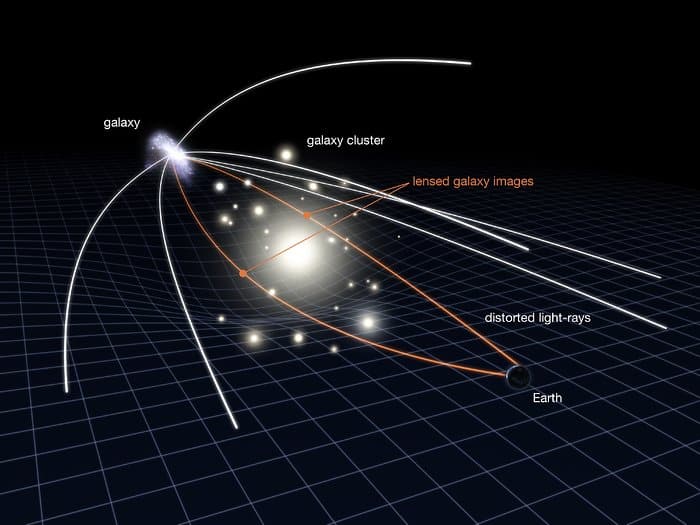By Monika Sachan

Space- Beautiful or Mysterious!!!
Have you ever wondered, the beautiful images of space that we see on the internet, how they form in space?
Nature has its own visual effects creation mechanism and we humans have made eyes that can see beyond the point in space, enhance them, and helps to solve hideous facts about space. Telescope, an artificial eye with many features.
A gravitational lens is the distribution of matter or creation of a gravitational field that distorts and magnifies the light from the distant object like a cluster of galaxies that are behind it. The whole process of distortion and magnification together is Gravitational Lensing. This acts like a big magnifying glass.
A gravitational lens induces a maximum deflection of light that passes closest to its center and a minimum deflection of light that furthest from its center which means instead of having a single focal point, the gravitational lens has a focal line. If the light source, the lensing object, and the observer are in a straight line, the original light source will appear as a ring but if there is a slight unbalancing between the former three entities, an arc will appear (Einstein Ring, first quantified by Einstein in 1936). Hubble telescope makes it possible to look for these Einstein rings for astronomers.
Gravitational lensing is complex when a cluster of galaxies is taken into consideration.
An uneven and non-circular symmetric, when there is no center in the distribution of matter in galaxy clusters. In such cases, short, thin “lensed arcs” are formed at the outskirts of clusters as a result of gravitational lensing of background galaxy.
The images obtained through lensing is a source of information of matter distribution in the galaxy cluster. This matter distribution of galaxy cluster images results that the most of the matter is not in the visible galaxies or hot gases around them and does not emit light and hence, known as dark matter.
Obtained images of galaxy cluster shows the distribution of visible as well as dark matter. Hubble’s take images of gravitational lensing of galaxy clusters that is helpful in creation of maps of dark matter.
In succession, the images of matter distribution are helpful in better understanding and analysis of gravitationally lensed images. A model of matter distribution is helpful in identifying the images of same galaxy or predicting where the most distant galaxies are likely to emerge in a galaxy cluster image. Astronomers uses images from gravitational lensing and matter distribution for better understanding of both.
When Hubble moving further into space, faint images of background galaxies are obtained but gravitational lensing not only distorts the images, amplifies light as well.
Classes of Gravitational Lensing
- Strong lensing: Easily visible distortions such as the formation of Einstein rings, arcs and multiple images.
- Weak lensing: Distortions of background sources are much smaller and can only be detected by analysing large numbers of sources in a statistical way to find coherent distortions of only a few percent. To obtain observable results, large number of sources needs to be considered.
- Microlensing: No distortion in shape can be seen but the amount of light received from the background objects changes with time. The lensing object may be stars in the Milky Way in one typical case, with the background source being stars in a remote galaxy, or, in another case, an even more distant quasar.
Classes of lensing helps in finding new objects of space, planets outside our solar system have been discovered using microlensing techniques. A statistical analysis of specific cases of observed microlensing over the time period of 2002 to 2007 found that most stars in the Milky Way galaxy hosted at least one orbiting planet within .5 to 10 AUs.
The Frontier Fields project has examined multiple galaxy clusters, measured their lensing and matter distribution and identified a collection of these most distant galaxies.
In future, gravitational lensing images and matter distribution in cluster galaxies will be helpful for James Web Space Telescope along with data provided by the Hubble telescope. Hubble telescope will guide the James Web Space Telescope to push further into cosmos.
















3 Responses
very perfectly explained by Monika. Waiting for more such articles !!
Thank you Anuj, keep supporting. Don’t forget to download our Mobile Web Application, available on our website.
Very nicely explained !!